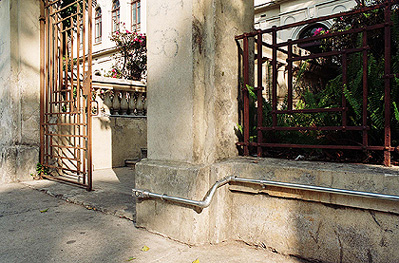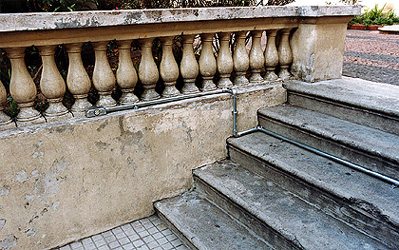 |
Rubens Mano | ||||||||
|
Rubens Mano on Light and Power LILIAN TONE For Pavement, the artist Rubens Mano (born São Paulo, 1960) installed electric outlets next to a sidewalk in downtown São Paulo during six weeks in July and August of 1999, making electricity available to anyone twenty-four hours a day for the duration of the piece. Inverting the usual notions of what belongs inside and what belongs outside, this simple operation radically changed the dynamics of life in the street. Because of the ramshackle appearance of the industrial ducts that the artist extended somewhat erratically over the façade of the adjoining building, suspicious passersby kept asking the artist whether the authorities were aware of what he was doing, as if he were stealing electricity (the organic configurations of the ducts resembled the furtive water and electricity connections commonly found in self-built housing throughout the city.) Perplexed by the availability of free electricity, most found themselves unprepared to benefit from the offer. But the work did not exist solely as a potential offer. Some entrepreneurial street vendors did use it to expand their services and sales pitches, while homeless people cooked and installed electric lamps on the sidewalk. A popcorn vendor took advantage by hooking up a spotlight and extending his working hours late into the evening.
Especially evident in Pavement and Sewer is Mano’s interest in the tense and conflicted nature of the connections between public power and public good. Marked by an interest in impermanent situations and fragmented experiences, Mano’s work has been focusing since 1984 on light as a primary subject and tool, extending this attention towards the related areas of photography and architecture. The issue of site specificity is discussed in updated form, conceived as an intervention that is, in the artist’s words, "fluid and discursive," rather than "fixed and directed."2 In this respect, the work of Michael Asher, who sees himself as an author of situations, not of the elements involved in them,3 comes to mind. Asher’s rearrangement of the Kunsthalle Bern’s radiators in 1992 provides a parallel with Mano’s geometry of time 1998/99, in which the artist added to the already busy array of electrical conduits criss-crossing the ceiling of São Paulo’s Paço das Artes, transforming what were previously only distracting features into a vast viewing ground. While Asher’s installations, perhaps out of ethical concerns, are marked by a withdrawal of visual pleasure, most of Mano’s works embrace beauty as a powerful tool, without detriment to their insistent responsiveness to the unique geographical, social and temporal set of conditions of the chosen site. They often mesmerize viewers with their blinding nature, mixing lyricism with science fiction, while retaining a certain ambiguity by visiting the limits of visibility. The other-worldly appearance of works like Detector of Absences (1994), São João Receives São Paulo, and White Cue (both 1999) invents a place where before there was none, both unobtrusively and ubiquitously.
Even though this phenomenon only emerged in the last decade as a widespread occurrence, many of the issues at stake were prefigured in work from the 60s and 70s, especially those more ephemeral in nature. During that period, several artists formulated a critique of art’s traditional forms, its institutional context, and its mode of audience address. They chose to focus, instead, on art’s instrumentalist potential, not unlike many artists who emerged over the last ten years. Following John Cage’s credo that the goal of the artist should be to provide "practice zones for fully conscious living," Fluxus artists framed life as art, operating under the assumption that, on one hand, there should be no hierarchy between artist and audience, and, on the other, that meaning was not to be drawn from the object, but from the situations provoked by it. As Yoko Ono remarked, "The object is not really the point of the work. Usually the object is just something that would take the spectator on from there." In the 60s and 70s, Latin American artists like Lygia Clark and Helio Oiticica, in particular through works like her performances and his Nests and other "penetrable" installations, took geometric abstraction as a departure point to expand the scope of their experimentation towards the performative, resorting to means that increasingly addressed the social and the political. Oiticica remarked in 1966, "Anti-Art, in which the artist understands his/her position no longer as a creator for contemplation, but as an instigator of creation – ‘creation’ as such: this process completes itself through the dynamic participation of the ‘spectator’, now considered ‘participator’."4 The desire here is to make art that does not place itself in a position of authority in relation to its audience, art that establishes an antagonistic, intimidating relationship with the viewer. For these artists, neither do the works have the last word, nor is the viewer a disinterested bystander. They strive to create works that inspire the viewer to realize his or her own sense of authority, to make use of his or her rights and options, which include the option to be engaged and to contribute. The mere disruption of the viewer’s contemplative passivity brings about a measure of ambivalence. As Dan Graham wrote, "In this traditional, contemplative mode, the observing subject not only loses awareness of his or her "self" but also loses consciousness of being part of a present, social group, located in a specific moment and social reality, occurring within the architectural frame where the work is presented."5 In a dialogue with the traditions of institutional critique and site specificity, Mano's work often promotes what could be called a situational displacement, heightening awareness of the shifting frame that defines the spaces where art is shown: spaces marked by unstated formal and ethical codes, in which accepted rules of engagement prevent any degree of usage of the artwork and discourage ordinary reflexes of attraction. In this way, they simultaneously generate comfort and discomfort, freedom and self-consciousness, and pose, to institutions and viewers, a challenge to their powers of adaptability. | |||||||||
 |
Rubens Mano | ||||||||
|
Notes: 1. Rubens Mano, email sent to author.
| |||||||||

